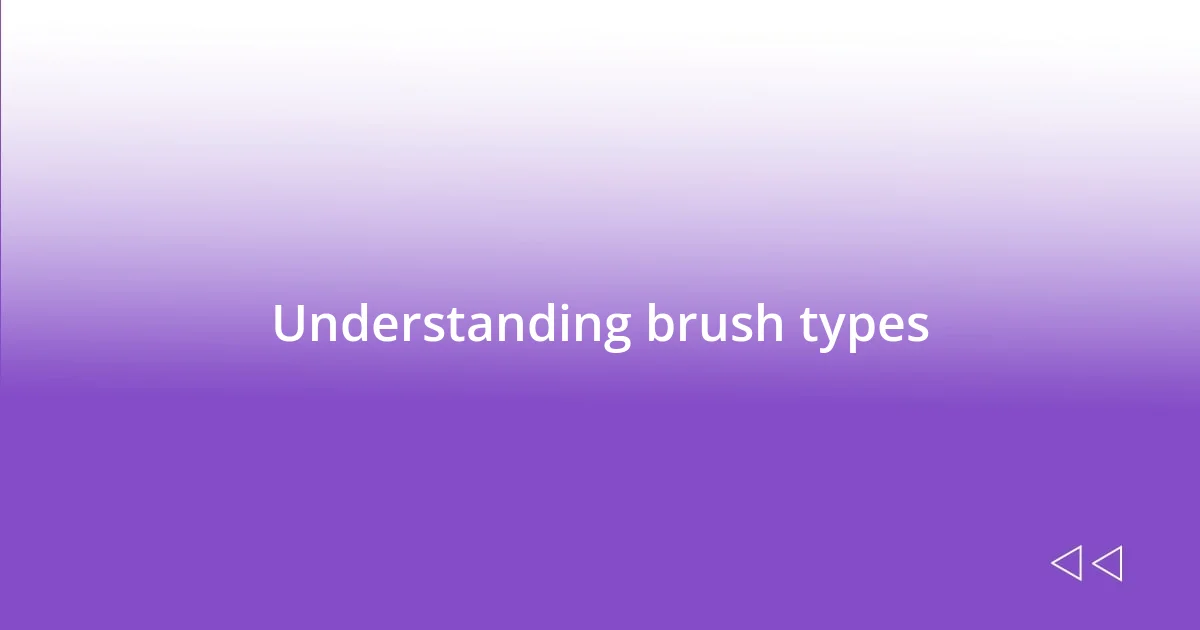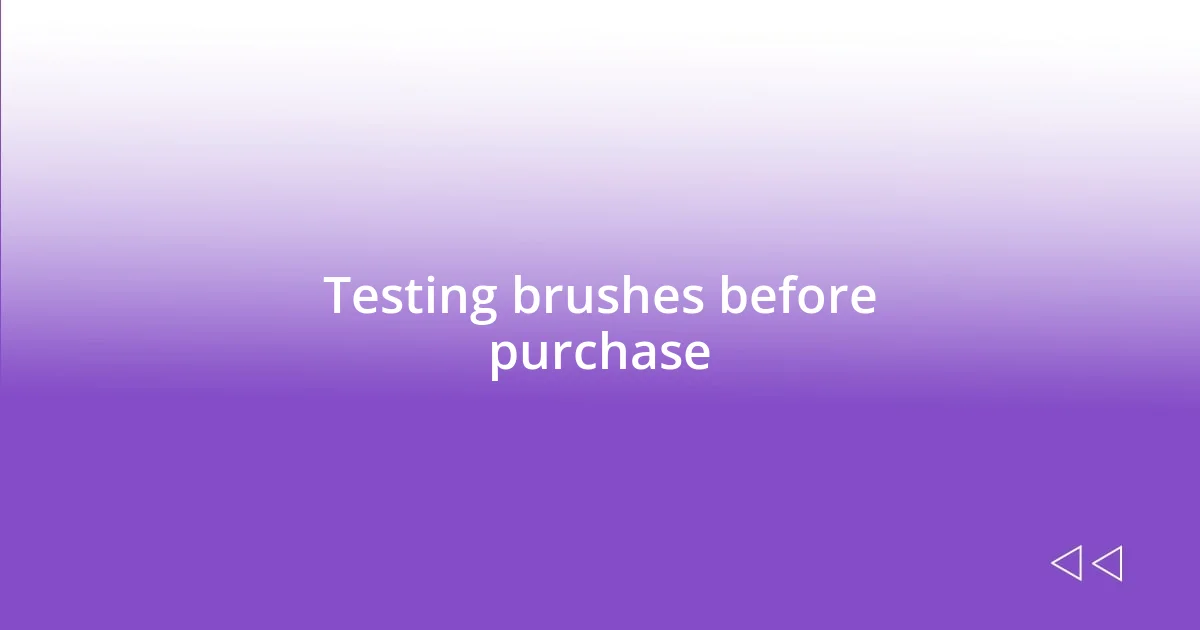Key takeaways:
- Understanding brush types, shapes, and sizes is crucial for achieving desired effects and enhancing creativity in painting.
- Evaluating brush materials, such as natural vs. synthetic bristles, significantly influences paint application and the overall artistic experience.
- Regular maintenance and proper testing of brushes before purchase contribute to their longevity and improve performance over time.

Understanding brush types
When I first started painting, the variety of brush types left me overwhelmed. Did you know that choosing the wrong brush can really alter your artwork? For instance, a flat brush is fantastic for bold strokes and even washes, while a round brush is perfect for detail and precision. I learned this the hard way when I tried using a round brush for large areas; it was an exercise in frustration!
There’s something truly satisfying about understanding the different brush shapes and sizes. For example, filbert brushes combine the best qualities of both flat and round brushes, and they create soft edges that are perfect for blending. I’ve often felt like a painter’s toolbox is like a musician’s instrument collection – each brush has its unique sound, or in this case, effect. Have you ever felt that rush of excitement when you discover a brush that perfectly matches your style? It’s illuminating!
Knowing the bristles is just as important as understanding the shapes. For instance, synthetic brushes are great for acrylics and watercolors because they hold shape well, while natural hair brushes often provide a sumptuous feel and fluid application for oils. I remember my first purchase of a sable brush—it felt luxurious in my hand and added an entirely new dimension to my painting. Have you explored this yet in your journey? It can truly elevate your work.

Evaluating brush materials
Choosing the right brush material can significantly impact your painting experience. In my early days, I experimented with various materials and quickly learned that the choice of bristles affects everything from the paint’s application to the final texture. There’s something fascinating about how a single brush can change the way a color interacts with the canvas.
When evaluating brush materials, consider these key points:
-
Natural Hair Bristles: They often offer superior paint pickup and a softer application, which can make a noticeable difference in blending. My first time using a squirrel hair brush brought a delightful fluidity to my watercolor work that I hadn’t achieved before.
-
Synthetic Bristles: They tend to be more durable and versatile, making them perfect for beginners. I remember feeling relieved when I found a synthetic brush that held its shape even after countless uses; it gave me the confidence to explore different techniques without worrying about wear and tear.
-
Mix of Both: Some brushes use a blend of natural and synthetic hairs to provide the best of both worlds. I’ve found that these hybrid brushes work wonders for acrylics, providing both flexibility and control that cater to my style.
Evaluating these materials based on your personal preferences can lead to a brush that feels just right in your hand, transforming your painting process into something truly delightful.

Identifying brush sizes
Identifying the right brush size can sometimes feel like navigating a labyrinth. Each size serves a particular purpose, and realizing this has changed my approach to painting entirely. For example, I often find myself reaching for the detail brush when I’m working on intricate areas; it allows me to unleash my creativity without fear of overstepping my intended design. The surprise for me came when I discovered that a larger brush could also create fine lines if wielded correctly – a technique I stumbled upon during an impromptu painting session.
Different sizes of brushes facilitate various strokes and styles, making it essential to understand their application. A flat brush, which I initially dismissed as too simple, turned out to be my go-to for bold backgrounds and sweeping strokes. Meanwhile, I learned that using a tiny liner brush on a larger canvas can help incorporate details that add depth to the whole piece. Have you ever marveled at how the right brush size can bring about unexpected layers of complexity to your art?
As I delve deeper into brush sizes, I find the need to keep a variety in my collection. Small brushes excel at detail and precision, while larger brushes are perfect for those foundational washes. Understanding the range can empower you to explore different facets of your artistry. A rounded brush, for example, allows for versatility in size and stroke without needing to switch tools frequently. It’s exhilarating to realize how such a small detail—like size—can have such a massive impact on your artwork’s outcome.
| Brush Size | Recommended Usage |
|---|---|
| Small (0-3) | Detail work, fine lines, and intricate designs |
| Medium (4-8) | General painting, blending, and moderate detail |
| Large (9 or more) | Bold strokes, washes, and background application |

Matching brushes to techniques
Finding the right brush for specific techniques has been a game changer for my painting journey. For instance, when I first ventured into oil painting, I learned that using a stiff bristle brush allowed me to create those luscious, textured strokes that make the medium so captivating. I still recall that moment of joy when I saw how those bold strokes transformed my canvas in a way that softer brushes couldn’t replicate.
As I delved into techniques like dry brushing, I discovered that using a brush with a scruffy texture—something I initially frowned upon—was actually the secret to achieving that desired effect. It’s incredible how something that felt so counterintuitive led to a breakthrough in my work! Have you ever experimented with a tool you weren’t fond of only to find it sparks something magical? That’s how I felt when I used a stiff fan brush for foliage; it made creating layers effortless and incredibly satisfying.
I also realized that for blending techniques, a soft, flat brush became an indispensable part of my toolbox. The way it glided over the surface gave my paintings an ethereal quality I had only dreamed of achieving. This experience truly solidified my belief that matching your brush to your chosen technique can elevate your art to new heights, inviting a delightful exploration of styles and expressions. Isn’t it fascinating how such a simple adjustment can lead to remarkable transformations?

Considering brush shapes
When I consider brush shapes, it’s akin to choosing a sculptor’s tool for the right curve. For example, I’ve found that a filbert brush, with its oval shape, is fantastic for blending while still allowing me to achieve defined edges. I remember my first experience with a filbert; it made those gentle transitions in my painting feel seamless, almost like magic. Have you experienced that moment when the right brush just makes things flow effortlessly?
Then there’s the fan brush, which at first seemed gimmicky to me. I was skeptical until a friend suggested I try it for creating textures in grass and leaves. Using it not only changed my approach to landscapes but also injected a joy into my process, as it felt like I was playfully dabbing little bits of nature onto the canvas. The way the bristles spread out allows for a layering effect that can visually elevate an outdoor scene. Who knew such a unique shape could open up a whole new world of creativity?
Lastly, I can’t overlook the impact of a round brush—often my first choice when tackling detail or delicate lines. But here’s the catch: the shape can also be my best ally in creating those sweeping washes I crave. I recall a specific moment when I used a round brush not only for fine details but also to create beautiful circular strokes that brought my painting to life. The adaptability of brush shapes never ceases to amaze me! Have you ever experimented with a brush and discovered new techniques along the way? That journey of exploration is what keeps art invigorating.

Testing brushes before purchase
Testing brushes before making a purchase is a crucial step in my art journey. Whenever I visit an art supply store, I can’t help but gravitate toward the brush section. I always take the time to pick up each brush, feeling the bristles against my hand. It’s fascinating to me how the tiniest difference in texture can significantly impact my painting experience. Have you ever paused to truly feel how a brush interacts with your skin? It can tell you a lot about how it will perform on canvas.
I remember one instance when I was unsure whether to splurge on a high-end brush or stick with my usual picks. So, I decided to test a few out right there in the store. Dipping the brushes in paint and sweeping them across paper allowed me to see the variety of strokes they could create. That moment of exploration was exhilarating! It’s like dating for brushes—I needed to understand how they responded to my movements. Don’t you think that hands-on testing adds a whole new dimension to selecting the perfect tool?
Sometimes, I also ask store employees for their recommendations and insights. Hearing their opinions adds a layer of confidence to my choice; it’s like having a mini art mentor at my disposal. Have you ever sought out someone’s expertise just to see if it meshes with your own style? Those conversations have shaped my understanding as much as the brushes themselves, making the experience not just about the purchase, but an enriching part of my artistic growth. It’s incredible how testing brushes can guide you to tools that resonate with your creative spirit.

Maintaining brushes for longevity
Maintaining brushes for longevity requires a bit of a ritual, which I’ve come to enjoy as part of my creative process. After every painting session, I always give my brushes a gentle wash with warm, soapy water. It’s a simple act, but I often find myself reflecting on the care I give my tools, almost as if I’m thanking them for helping me express my ideas. Have you ever thought about what your brushes go through during your artistic journey?
Drying them properly is equally essential. I make it a point never to stand them upright in a container to avoid damaging the bristles. Instead, I lay them flat on a clean cloth and allow them to air dry. There’s something satisfying about taking the time to treat my brushes well, knowing they’ll return the favor through better performance over time. Have you experienced that gradual shift in tone and texture when using a well-kept brush?
Lastly, I always reshape the bristles after washing. It sounds minor, but I gently form the brush back to its original shape before letting it dry. I recall an instance when I neglected this step, and the next time I painted, I struggled with uneven strokes. That frustrating experience taught me just how much attention brushes deserve. Have you ever had a moment that highlighted the importance of maintenance in your tools?














